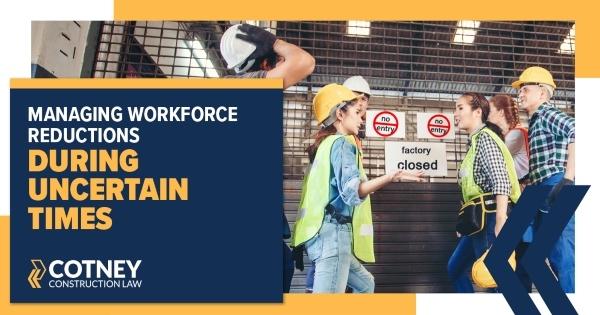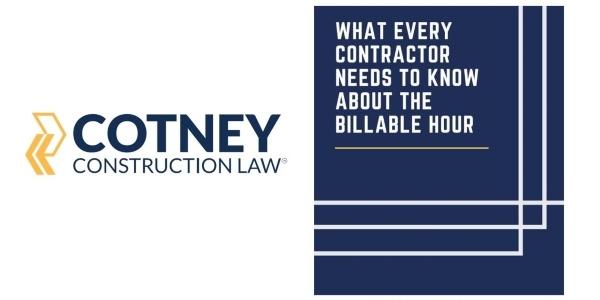Conducting Layoffs and Terminations During Economic Uncertainty

By Lauren White, RCS Reporter.
Learn the do’s and don’ts of managing reductions in your workforce while maintaining strong company culture and reducing liability.
The coronavirus pandemic has caused significant economic turmoil. Many companies are faced with reducing payroll, which is not an easy decision to make whether it’s being managed by a dedicated human resources department at a large construction business or by the owner of a smaller company. In this article, Cotney Construction Law will explain the process of managing layoffs and terminations. For employment law needs, they suggest consulting a construction attorney.
Layoffs and Terminating Employment
Conducting terminations or layoffs are some of the more difficult professional tasks. These two forms of separation, terminations and layoffs, are often used interchangeably but are very different. According to Cotney Construction Law, “Terminations are for cause. For example, poor performance or a violation of company policies can lead to an employee’s termination.” Layoffs occur for business-related reasons, such as downsizing, restructuring, or lack of work. With layoffs, the separation happens due to a driving force that is beyond the employee’s control.
The Balancing Act of Separations and Retainment
“Regardless of whether you’re conducting a termination or a layoff, construction businesses must protect themselves from liability when managing their form of separation,” Cotney Construction Law shares. The company faces a difficult balance of managing workforce reduction while also focusing on retainment. As employees watch their colleagues being let go it not only impacts company culture, but also leaves the remaining employees concerned for their future at the company. It’s imperative that companies have a process in place for these decisions and for them to handle them with precision.
An At-Will State
At-will employment states allow employers to terminate or layoff employees at their own discretion. “An employer can release an employee for any reason unless the separation violates the employment contract or the law,” according to Cotney Construction Law. It’s important for companies in an at-will state to consult an attorney to manage this process and ensure the company is protected before making an employment decision that cannot be reversed. Companies can face litigation or a claim being filed by a former employee if they fail to comply with the laws related to wage and hour discrimination. Contact a construction litigation attorney if faced with either of these circumstances.
Managing Layoff Meetings
There should be a strategy in place for managing this process regardless if the company has an HR department or department supervisors conducting the layoff meetings. Supervisors should be trained on what to say to the employee, keeping the explanation of their separation brief and direct. “Many companies prefer a script in place to help reduce liability. A script can also improve the chances of the meeting ending on good terms,” Cotney Construction Law shares. Some believe a script sounds rehearsed or insincere and use a checklist with a general outline instead.
When conducting layoffs, the supervisor can share the criteria used to determine which employees are released. Layoffs can be based on past performance reviews, specific skill sets, certifications obtained, or for progressive disciplinary reasons. “Providing fair, objective information to an employee may help prove that the separation decision is lawful. However, if one of your supervisors does elect to provide supporting documentation to an employee, it’s best to have a construction lawyer review the documents before the meeting,” explains Cotney Construction Law.
Create a Separation Task Sheet
A task sheet helps manage separation meetings, helping them go smoother and reducing any liability. Cotney Construction Law encourages employers to also consider the following:
-
What needs to be done: Review the terms of employment agreement and personnel file before releasing an employee. “If you are going to terminate their employment, implement a strategy for distributing the employee’s current workload and determine the best time and place to schedule the meeting for,” Cotney Construction Law discloses. If you’re conducting multiple layoffs in one day, consider scheduling gaps in-between the meetings.
-
Procure confidential information: Prior to meeting with an employee, consider if that employee is in possession of any company property or confidential information, such as passwords or computer systems. “Recover all company property from the employee and ask the employee to sign a termination release form before they leave the premises,” explains Cotney Construction Law.
-
Meet fiscal requirements: During the meeting, address issues such as an employee owing reimbursements or owing the employee paid time off or severance pay. Additionally discuss post-employment benefits such as healthcare continuation.
-
Consider the next step: After the employee’s separation, designate an HR representative or supervisor as the employee’s point of contact. Schedule an exit interview and choose a representative to conduct the interview if the employee is expected to have one.
Many businesses across the country are facing these same difficult employment decisions. By effectively executing the above tasks, you can ensure the separated employee is exiting your workplace on good terms, while also reducing liability and maintaining a strong company culture. Construction attorneys are available to navigate these decisions while keeping your business operational without disruption.
Consult an experienced construction attorney like Cotney Construction Law for employment law advice or company handbook drafting services.
Disclaimer: The information contained in this article is for general educational information only. This information does not constitute legal advice, is not intended to constitute legal advice, nor should it be relied upon as legal advice for your specific factual pattern or situation.






















Comments
Leave a Reply
Have an account? Login to leave a comment!
Sign In